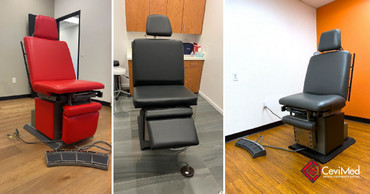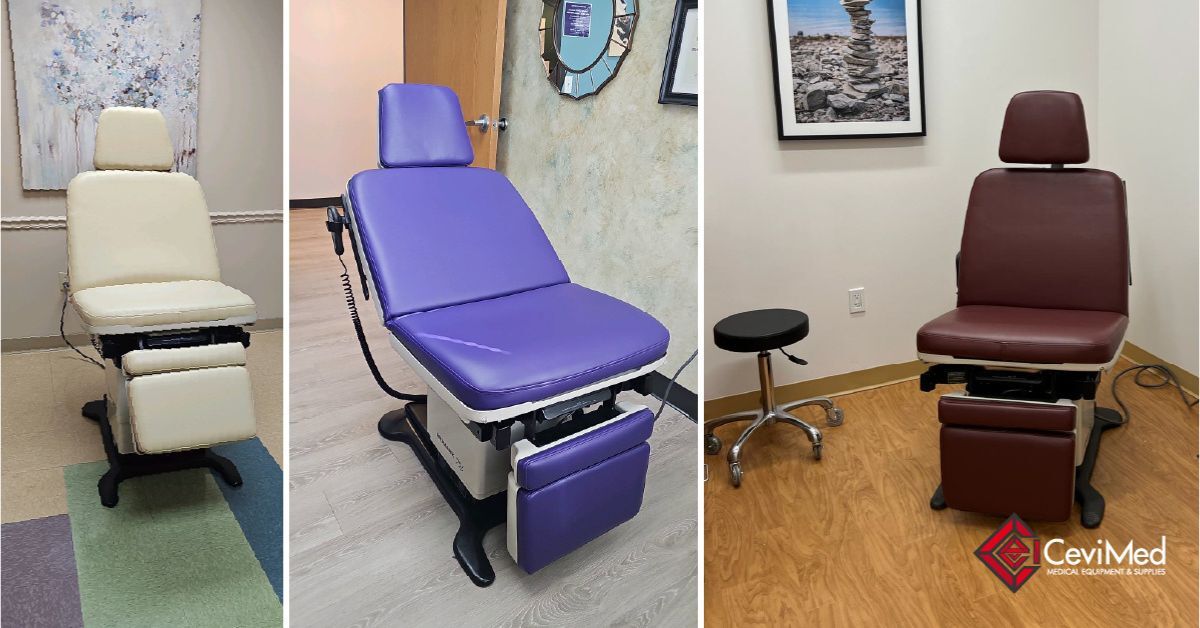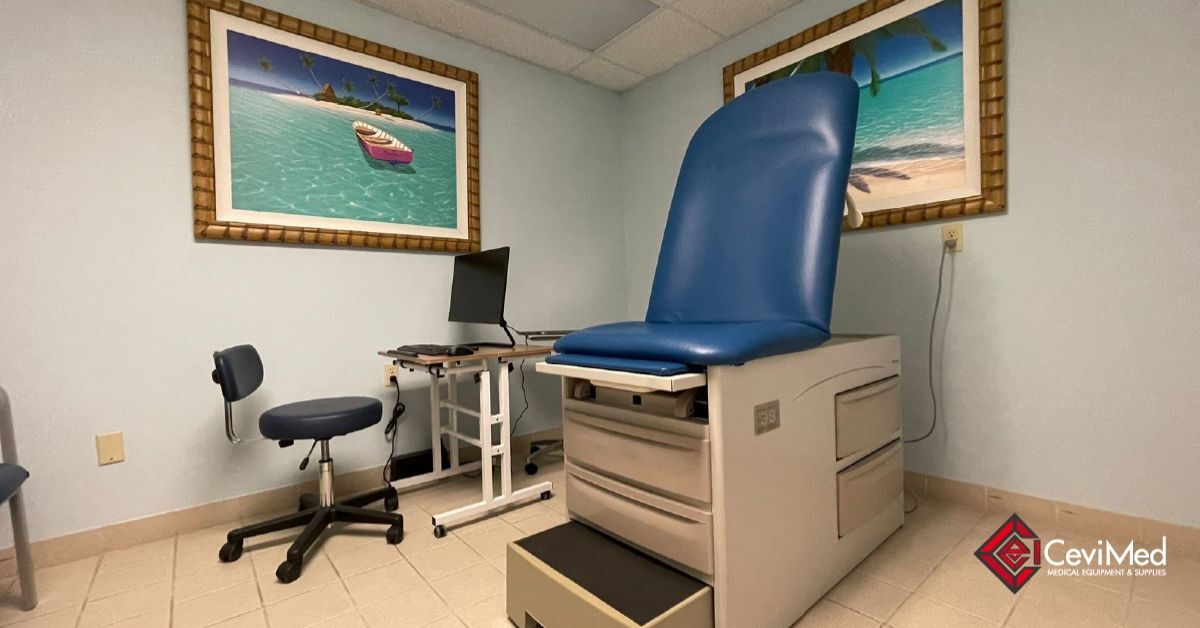
Used vs. New Medical Chairs: Pros & Cons
Posted by Cevi Med on 7th Aug 2025
Medical chairs are a common sight in healthcare facilities, supporting both practitioners and patients during examinations, procedures, and treatments. The decision between purchasing used or new directly affects your practice's operations, patient care quality, and financial health. Healthcare facilities, ranging from small private practices, are often left to decide between expanding services or replacing aging equipment.
Taking the time to consider the pros and cons of used versus new medical chairs will help you make an informed decision that aligns with your long-term goals. To make the decision easier, we'll examine both sides to help you determine the best path forward for your medical facility.
Common Applications for Medical Chairs
Medical chairs serve diverse purposes across healthcare settings.
- Examination Chairs: Used during routine check-ups and medical evaluations to provide comfort for patients while allowing easy access for healthcare professionals.
- Surgical Chairs: Specialized for minor procedures or surgeries, offering adjustable positions to enhance precision and patient support.
- Treatment Chairs: Used for administering treatments such as chemotherapy, blood transfusions, or IV therapy.
- Podiatry Chairs: Tailored specifically for lower extremity examinations and treatments, with adjustable foot and leg supports.
- OB/GYN Chairs: Crafted for gynecological examinations and procedures, often featuring advanced ergonomic adjustments for added comfort.
- Rehabilitation Chairs: Utilized in physical therapy sessions to help patients maintain proper posture and support recovery movements.
Each application demands specific features, from basic height adjustment to sophisticated electronic controls and specialized accessories. The intended use significantly influences whether used or new equipment better serves your needs.
Pros of Used Medical Chairs
Cost Savings
Used medical chairs generally cost much less than their new counterparts, freeing up capital for other essential equipment or facility improvements. Such substantial savings allow practices to acquire higher-quality models that might otherwise exceed their budget.
Smaller practices and startups, in particular, benefit from these savings, enabling them to establish operations with professional-grade equipment without incurring overwhelming debt. The reduced upfront investment also provides financial flexibility for unexpected expenses or growth opportunities.
Environmental Benefits
Purchasing used medical chairs extends the lifespan of equipment and reduces manufacturing demand. This choice supports sustainability initiatives, which are increasingly important to healthcare organizations and their communities.
Refurbished chairs often receive updated components and thorough inspections, combining environmental responsibility with reliable performance. Many healthcare facilities now prioritize sustainable practices, making used equipment an attractive option for demonstrating environmental stewardship.
Immediate Availability
Used medical chairs are often available for immediate delivery, eliminating lengthy manufacturing and shipping delays common with new equipment orders. This advantage proves crucial when replacing broken chairs or expanding services quickly.
Immediate availability also allows hands-on inspection before purchase, ensuring the chair meets your specific requirements. You can test functionality, assess condition, and verify compatibility with existing systems before committing to the purchase.

Cons of Used Medical Chairs
Limited Warranty
If used medical chairs carry shorter warranty periods or no warranty coverage, it could increase financial risk if problems arise. Repair costs become your responsibility, potentially offsetting initial savings.
Limited warranty protection also complicates budgeting for equipment maintenance and replacement. Without manufacturer backing, finding qualified repair technicians and replacement parts may prove challenging and expensive.
Potential Wear and Tear
Previous use inevitably causes some wear, even with proper maintenance. Upholstery may show signs of stains or deterioration, mechanical components may require adjustment or replacement, and electronic systems may develop intermittent issues.
Hidden problems may not surface until after purchase, leading to unexpected downtime and repair expenses. Even the most thorough inspection can't always guarantee against all potential issues that develop over time.
Outdated Features
Used chairs may lack current safety features, ergonomic improvements, or technological advances that enhance patient care and operator efficiency. Compatibility with modern accessories or software systems might be limited.
Regulatory changes could also impact older models, potentially requiring costly modifications or earlier-than-planned replacements to maintain compliance with current healthcare standards.
Pros of New Medical Chairs
Latest Technology
New medical chairs incorporate current innovations in patient positioning, operator controls, and safety features. Advanced electronics provide smoother operation, better reliability, and integration with modern healthcare systems.
These technological improvements often translate to better patient outcomes, increased efficiency, and enhanced practitioner satisfaction. Features such as programmable positions, improved ergonomics, and advanced safety systems justify higher costs through better performance.
Full Warranty
Comprehensive warranty coverage protects your investment and provides peace of mind. Manufacturer support includes technical assistance, replacement parts availability, and repair services throughout the warranty period.
Extended warranty options often provide additional protection, and established service networks ensure qualified technicians can address issues promptly. This support structure minimizes downtime and maintains consistent patient care capabilities.
Customization Options
New chairs offer extensive customization possibilities, from upholstery colors and materials to specific accessories and control configurations. This flexibility ensures the equipment matches your exact specifications and integrates seamlessly with existing workflows.
Custom configurations can address unique patient populations, specialized procedures, or specific space requirements. Manufacturers work directly with buyers to optimize chair specifications for their particular applications.

Cons of New Medical Chairs
Higher Cost
New medical chairs require substantially higher upfront investment, potentially straining budgets or requiring financing arrangements. Premium models with advanced features can cost tens of thousands of dollars.
The higher cost may force compromises in quantity or quality, potentially limiting practice capabilities or requiring phased equipment acquisition over time. Budget constraints might also delay other important purchases or facility improvements.
Depreciation
New medical chairs lose value rapidly once delivered, similar to vehicles or other manufactured goods. This depreciation affects the resale value of equipment and may impact financial statements for larger healthcare organizations.
The depreciation rate varies by manufacturer and model, but typically follows predictable patterns that should be factored into long-term financial planning. Leasing options may offer alternatives that address concerns about depreciation.
Tips for Finding Quality Used Medical Chairs
Research the chair before your purchase.
- Inspect the chair's physical condition carefully, checking for any signs of damage, wear, or malfunction.
- Verify the manufacturer's reputation and ensure the model is known for durability and reliability.
- Test all adjustable features, such as reclining mechanisms and height adjustments, to ensure they function smoothly.
- Look for certifications or labels that verify the chair meets safety and ergonomic standards.
- Compare pricing with similar models from other sellers to ensure you are getting a fair deal.
If possible, seek feedback from others who have used the same model to gain insight into its long-term performance.
Finding the Right Used Medical Chair Supplier
Reputable suppliers understand healthcare requirements and can guide you toward the most suitable models for your specific needs. Look for suppliers with established relationships with healthcare facilities and positive reviews from previous customers.
Professional refurbishment capabilities indicate serious commitment to quality and customer satisfaction. Verify the supplier's ability to provide technical support, replacement parts, and service referrals. Reliable ongoing support proves as important as the initial purchase transaction for long-term satisfaction.
Making the Right Choice for Your Practice
The decision between used versus new medical chairs depends on your specific circumstances, budget constraints, and quality requirements. Practices with limited resources often find excellent value in quality used chairs from reputable suppliers.
Are you looking for used medical exam tables, chairs, or other equipment? Then, you're in luck. At Cevi Med, we recognize the importance of providing affordable, high-quality medical supplies. With our refurbished options, you won't have to dig too deep to ensure your customers are well cared for.
